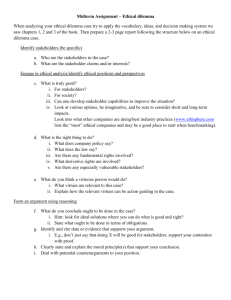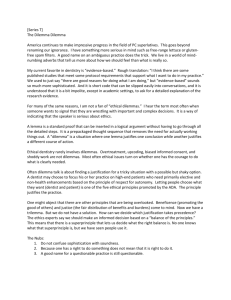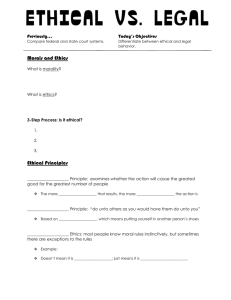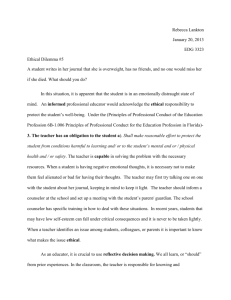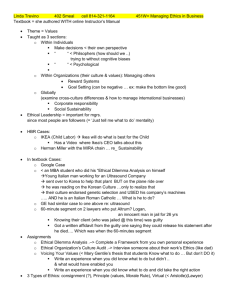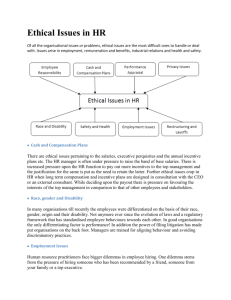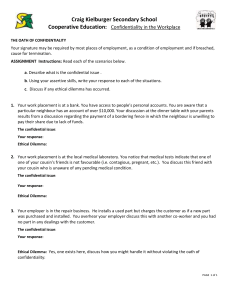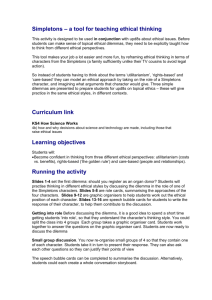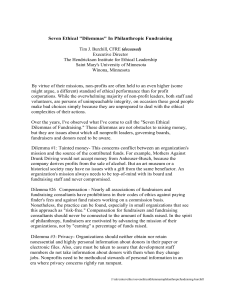Ethical Dilemma Model: A Counselor's Guide
advertisement
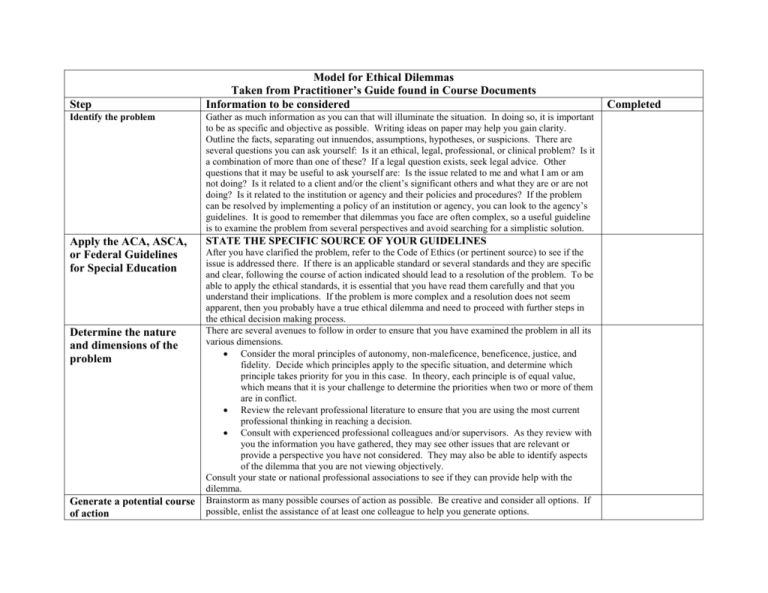
Step Model for Ethical Dilemmas Taken from Practitioner’s Guide found in Course Documents Information to be considered Identify the problem Gather as much information as you can that will illuminate the situation. In doing so, it is important to be as specific and objective as possible. Writing ideas on paper may help you gain clarity. Outline the facts, separating out innuendos, assumptions, hypotheses, or suspicions. There are several questions you can ask yourself: Is it an ethical, legal, professional, or clinical problem? Is it a combination of more than one of these? If a legal question exists, seek legal advice. Other questions that it may be useful to ask yourself are: Is the issue related to me and what I am or am not doing? Is it related to a client and/or the client’s significant others and what they are or are not doing? Is it related to the institution or agency and their policies and procedures? If the problem can be resolved by implementing a policy of an institution or agency, you can look to the agency’s guidelines. It is good to remember that dilemmas you face are often complex, so a useful guideline is to examine the problem from several perspectives and avoid searching for a simplistic solution. Apply the ACA, ASCA, or Federal Guidelines for Special Education STATE THE SPECIFIC SOURCE OF YOUR GUIDELINES Determine the nature and dimensions of the problem Generate a potential course of action After you have clarified the problem, refer to the Code of Ethics (or pertinent source) to see if the issue is addressed there. If there is an applicable standard or several standards and they are specific and clear, following the course of action indicated should lead to a resolution of the problem. To be able to apply the ethical standards, it is essential that you have read them carefully and that you understand their implications. If the problem is more complex and a resolution does not seem apparent, then you probably have a true ethical dilemma and need to proceed with further steps in the ethical decision making process. There are several avenues to follow in order to ensure that you have examined the problem in all its various dimensions. Consider the moral principles of autonomy, non-maleficence, beneficence, justice, and fidelity. Decide which principles apply to the specific situation, and determine which principle takes priority for you in this case. In theory, each principle is of equal value, which means that it is your challenge to determine the priorities when two or more of them are in conflict. Review the relevant professional literature to ensure that you are using the most current professional thinking in reaching a decision. Consult with experienced professional colleagues and/or supervisors. As they review with you the information you have gathered, they may see other issues that are relevant or provide a perspective you have not considered. They may also be able to identify aspects of the dilemma that you are not viewing objectively. Consult your state or national professional associations to see if they can provide help with the dilemma. Brainstorm as many possible courses of action as possible. Be creative and consider all options. If possible, enlist the assistance of at least one colleague to help you generate options. Completed Consider the potential consequences of all options and determine a course of action. Evaluate the selected course of action. Implement the Course of Action Considering the information you have gathered and the priorities you have set, evaluate each option and assess the potential consequences for all the parties involved. Ponder the implications of each course of action for the client, for others who will be affected, and for yourself as a counselor. Eliminate the options that clearly do not give the desired results or cause even more problematic consequences. Review the remaining options to determine which option or combination of options best fits the situation and addresses the priorities you have identified. Review the selected course of action to see if it presents any new ethical considerations. Stadler (1986) suggests applying three simple tests to the selected course of action to ensure that it is appropriate. In applying the test of justice, assess your own sense of fairness by determining whether you would treat others the same in this situation. For the test of publicity, ask yourself whether you would want your behavior reported in the press. The test of universality asks you to assess whether you could recommend the same course of action to another counselor in the same situation. If the course of action you have selected seems to present new ethical issues, then you’ll need to go back to the beginning and re-evaluate each step of the process. Perhaps you have chosen the wrong option or you might have identified the problem incorrectly. If you can answer in the affirmative to each of the questions suggested by Stadler (thus passing the test of justice, publicity, and universality) and you are satisfied that you have selected an appropriate option. Taking the appropriate action in an ethical dilemma is often difficult. The final step involves strengthening your ego to allow you to carry out your plan. After implementing your course of action, it is good practice to follow up on the situation to assess whether your actions had the anticipated effect and consequences. You will not address this step unless you actually follow through.

